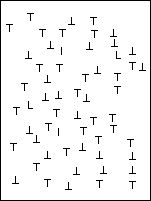 |
| COLOR AND POPOUT
Complicated graphics often include a large number of small symbols distributed across a background. There are many ways to graphically distinguish subsets of symbols, but only a few of those ways will cause the subset to be immediately apparent, to perceptually stand out as a separate group from the other symbols. All the other graphic distinctions require "serial search"--you have to look at the symbols one by one to see if each is in the subset. This phenomenon of preattentive perceptual isolation is called "popout" in the jargon of perception research. Hue is one of the symbol attributes that is capable of producing popout. More than one subset can be distinguished with hue, but overuse reduces the strength of the effect. This should especially be avoided when the popout is being used as part of a hazard alert.
|
||||
| Find the "L"s and "I"s:
|
There are two "L"s and two "I"s in these figures. The red and magenta codings on the right make them stand out instantly, without having to inspect each symbol. | |||
| |
Here the "I"s are still magenta, but they are slightly harder to locate due to the addition of three more hue coded subsets. | |||
|
Related Topics:
| ||||
